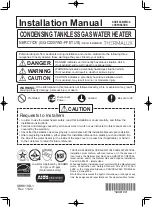
8 716 473 147
12
Installation instructions
3.6
Measuring gas pressure
Connecting manometer
B
Shut off gas.
B
Remove front cover and locate inlet gas pressure
measuring point just above the regulator.
B
Loosen screw from test point on the left side of gas
valve and connect manometer tube on test point.
Static pressure test
B
Turn gas supply back on.
B
Operate all other gas appliances on same gas piping
system at maximum output.
B
Record static gas pressure reading on back page of
manual.
Operating pressure test
B
Run high hot water flow rate.
B
Set flow control knob fully clockwise.
B
Set slide control to the right.
B
Record operating gas pressure reading on back
page of manual.
Gas pressures lower than 5.7" W.C. for Natural Gas or
10.5" W.C. for LP Gas will result in insufficient degree
rise to the hot water being used, and must be corrected.
See Gas Line Sizing under chapter 3.5.
3.7
Water connections
When facing the heater, the ½” cold water inlet is on the
bottom right and the hot water outlet is on the bottom
left.
B
INSTALLING A UNION WHEN CONNECTING
BOTH WATER PIPES TO THE INLET AND
OUTLET CONNECTIONS WILL FACILITATE
ANY NECESSARY SERVICING AND REQUIRED
CLEANING.
Although water piping throughout your structure may be
other than copper, we recommend that copper piping
or suitably rated stainless steel flex line piping be used
for at least three feet before and after the heater (follow
local codes if more stringent). Never sweat any rigid
piping directly to or beneath the water connections,
damage can occur to the internal water valve from
heating of the pipe. Plastics or other PEX type plumbing
line materials are not recommended for connecting
directly to the water heater. Keep water inlet and outlet
pipes to no less than ½" (12.7mm) diameter to allow the
full flow capacity.
It is recommended that all water piping below the
heater be properly insulated to avoid heat loss.
If
below freezing temperatures are ever anticipated where
the heater is located, insulation material is required and
must be capable of protecting the piping from freezing.
The freeze protection provided with the heater will not
prevent any freeze damage to the exterior water piping.
If the cold and hot connections to the heater are
reversed, the heater will not function. Be certain there
are no loose particles or dirt in the piping. Blow out or
flush the lines before connecting to the water heater.
Full port valves should be installed on both the cold
water supply and hot water outlet lines to facilitate
servicing the heater (see Fig. 9). For installation on a
private well system with the use of a pressure tank, the
lowest pressure range setting recommended is 30-50
psi (2.07 and 3.45bar).
Connecting the pressure relief valve (PRV)
A listed pressure relief valve supplied with the heater
must be installed at the time of installation. No valve is
to be placed between the PRV and the heater. No
reducing coupling or other restriction may be installed
in the discharge line. The discharge line must be a
minimum of 4” above a drain and installed such that it
allows complete drainage of both the PRV and the line.
The location of the PRV must be readily accessible for
servicing or replacement, and be mounted as close to
the water heater as possible. See Fig. 9. To install the
PRV, a suitable fitting connected to an extension on a
“T” fitting can be sweated to the hot water line.
Support all piping.
Fig. 9
Plumbing Connections and Pressure Relief
Valve










































